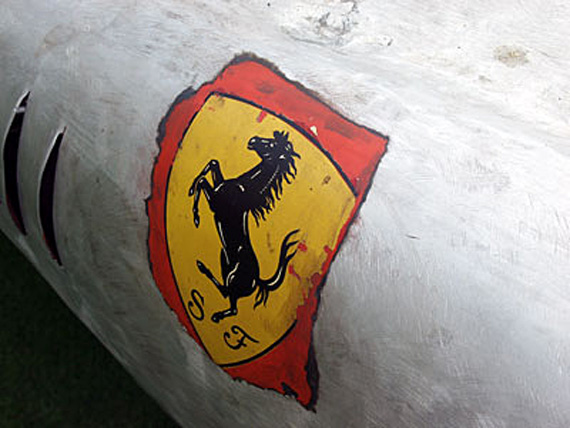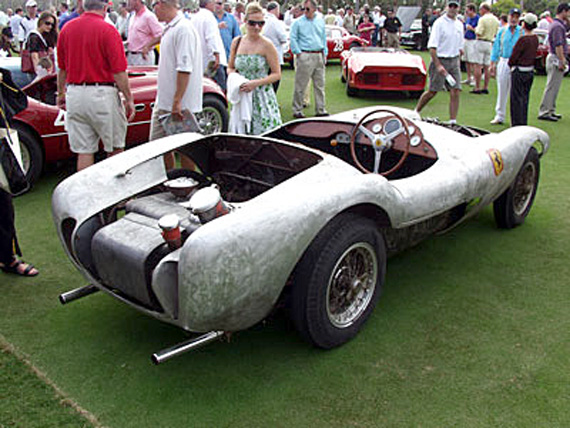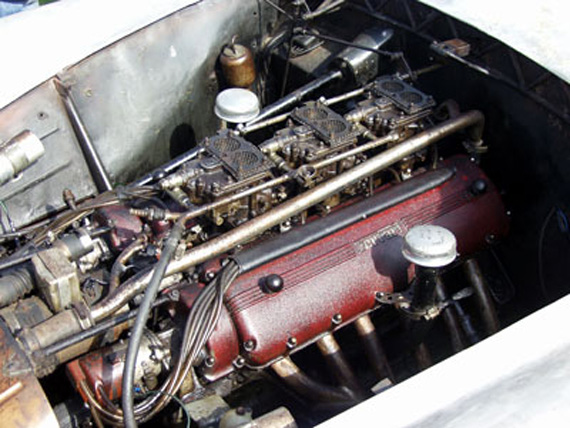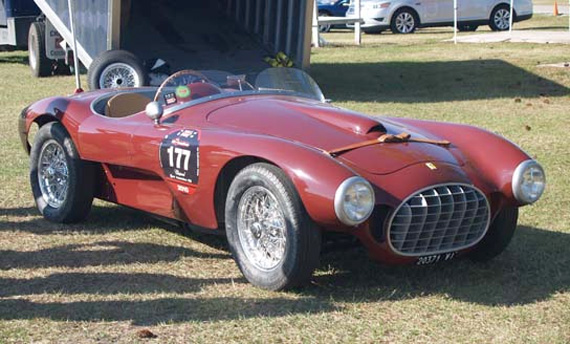Story by Werner Pfister
(History copyright Marcel Massini)
In which we take a look at another car which was left untouched for decades but is now restored. What would YOU have done?
Peter Markowski, owner of RPM Restorations, in Vergennes, Vermont, proudly displayed a very tired 212 Export (0086E), at Cavallino in 2006, in its first public showing in 38 years. Found in the proverbial barn, the barchetta had originally been owned and raced by the Marzotto brothers in 1951.
Markowski had known about the car for more than 40 years, when Stan Hallinan of Concord, NH, mentioned to him that he had purchased a Marzotto Ferrari. Markowski, of course, rushed over to see it, since he too, owned a Marzotto Ferrari. Amazingly, Markowski had purchased the first 340 America, at the tender age of fifteen.
Needless to say, Markowski was thrilled to see the Marzotto barchetta, and asked Hallinan if he could have first right of refusal, should the car ever be offered for sale. He had to wait almost forty years, but eventually Hallinan decided to sell, and made good on the first right of refusal. Markowski jumped at the chance.
0086E began life when the Marzotto brothers purchased the car from Ferrari in 1951 as a bare chassis. They commissioned Carrozzeria Fontana of Padua to construct a racing body which has often been called a “Carretto Siciliano”, or “Sicilian cart.” Marzotto achieved successes with this car in its inaugural event, winning first overall in the Giro di Sicilia, but dnf’d at the Targa Florio the same year.
Subsequently, the Fontana body was removed and Vignale rebodied the car as an export spyder. In a strange twist of fate, the Fontana body wound up on the same 340 America which Markowski would purchase as a fifteen year old enthusiast. In rapid succession, Marzotto had Fontana put a shooting brake type body on 0086E, and eventually back to a spider body reconfigured out of the first body!
In April of 1952, the 212 returned to competition at the Giro di Silicia and placed 7th, and again dnf’d at the bigger event, the Mille Miglia. In the late 1950s, at the end of its competitive life, the car found its way to Jim Flynn, who competed in a race at Watkins Glen in 1959.
Forty years ago, when Markwoski first saw Hallinan’s Marzotto, the body was still painted. But in 1967, Hallinan decided to strip the paint. Interestingly, although not a factory team car, the Marzotto 212 sported large Scuderia Ferrari decals, and thankfully, these were spared from the paint remover. 0086E still proudly displays the Scuderia Ferrari prancing horse on its flanks.
During the next 38 years, the car was stored in a barn and was the home to an extended family of rodents. Years of neglect and major doses of D-Con rodent poison took their toll in the engine bay.
After getting the 212 home, Markowski immediately set about to clean the engine of debris. He doused the entire engine compartment with Marvel Mystery oil to put a lid on the decades-old embedded odors. And that’s the way the car was displayed at Cavallino.
Markowski said that the drive train is entirely original, which is one of the reasons he always wanted this car. He had to sell the 340 several years ago, and says that this 212 was a “keeper”. However, it was sold to Peter Carlino who showed the car, completely restored, at Cavallino in 2911 and Amelia in 2012.
Did they do the right thing? Let us know what you think.
Ferrari 212 Export 1951, Chassis# 0086 E
Engine internal #10/E
Copyright Marcel Massini 10/30/02
| February 22, 1951 | Chassis sold to WI.PU.CO., Via Larga 8, Milan, Italy, for first owner Count Vittorio Marzotto, Valdagno/Italy Certificate of origin #118 issued |
|
| March 1951 | Much delayed the new chassis frame arrived from the Ferrari factory for the Scuderia Marzotto of Valdagno, Italy Giannino and Vittorio Marzotto had the naked chassis BODIED by Carrozzeria Paolo Fontana of Padua as an ugly and very crude “Sicilian chariot” or “Carretto Siciliano” „h1 (see also Prancing Horse magazine, issues# 86 and 87) |
|
| March 20, 1951 | Registered on Italian license plates of Vicenza SVI 20371¡¨ |
|
| April 1, 1951 | Raced at the XI Tour of Sicily by Count Vittorio Marzotto and co-driver Paolo Fontana, race #440, placed 1st OA (pictured on pages 201/202 of the book “Ferrari Automobili 1947-1953”, authored by Corrado Millanta, Luigi Orsini and Franco Zagari) (pictured page 71 of Pino Fondi’s book “Il Giro di Sicilia”) |
|
| May 8, 1951 | Engine 0086 E was equipped with three carburetors instead of the original single one |
|
| 1951 | REBODIED by Carrozzeria Vignale of Turin as a spider (similar to chassis #0076 E) |
|
| July 15, 1951 | Raced at the Grand Prix of Portugal at the Circuito Vila real by Giovanni Bracco, race #14, placed 1st OA (pictured pages 74/75 of the book “Piloti Biellesi”, authored by Enzo Russo) |
|
| July 16, 1951 | Raced at the Lima Stadium Night Festival at Oporto by Bracco, race #16, placed 1st OA |
|
| Then | Following a design by Count Giannino Marzotto and Mr. Reggiani the car was REBODIED again by Fontana’s coachworks into a Station Wagon (type “Giardinetta” or “Famigliare”) It was said that the station car would be used as a spare parts transporter for the Carrera Panamericana in Mexico in November 1951. |
|
| Later | REBODIED again by Fontana, now as a spider with insweep body flanks |
|
| March 9, 1952 | Raced at the Tour of Sicily by Guido Mancini on race #464, still on Italian license plates “VI 20371” | |
| March 19, 1952 | Raced at the Grand Prix Siracusa by Sergio Sighinolfi, entered by Scuderia Marzotto, race #16, placed 2nd in the Gold Cup sports category |
|
| May 3, 1952 | Raced at the XIX Mille Miglia by Fabrizio Serena di Lapigio and co-driver Walter Piccolo, on race #628, still registered on license plates “VI 20371” as the car was on loan from the Scuderia Marzotto Shortly after Rome the car took fire |
|
| July 13, 1952 | Raced at the VI Coppa d’Oro delle Dolomiti by Guido Mancini, on race #102, placed 12th OA (pictured page 109 of Gianni Cancellieri and Cesare De Agostini’s book “Polvere e Gloria – La Coppa d’Oro delle Dolomiti 1947-1956”, published by Giorgio Nada Editore 2000) |
|
| March 14, 1953 | License plates changed by the Scuderia Marzotto from “VI 20371” to new license plates “VI 24196” (because the former license plates “VI 20371” had been “demolished” according to the ACI/PRA documents) | |
| 1953 | Raced by Serena and Mancini in Italy |
|
| May 24, 1953 | Raced at the Terni-Marmore hillclimb by Serena on race #925 (pictured in the Ferrari Yearbook 1953)) |
|
| August 15, 1953 | Raced at the Pescara 12 hours, XXII Coppa Acerbo, by Mancini-Serena on race #16 |
|
| October 7, 1953 | Sold to Guido Mancini, Rome, Italy | |
| January 10, 1954 | Re-registered on Italian license plates of Rome “Roma 193078” |
|
| Late 1950s | Owned by James A. Flynn, Syracuse/NY/USA (who also owned 290 MM Spider Scaglietti #0626) |
|
| October 17, 1959 | Raced at Watkins Glen by Flynn, race #138 4 (see page 15 of Prancing Horse magazine, issue# 52) |
|
| August 6, 1960 | Raced at Montgomery/NY by Flynn on race #238, placed 11th |
|
| June 24, 1961 | Raced at Watkins Glen/NY by Flynn |
|
| 1965 | Owned by Stan Hallinan, Concord/NH/USA | |
| December 2005 | Sold by Hallinan to Peter Markowski, Vergennes/VT/USA In unrestored original condition, unpainted, partially disassembled |
|
| January 21, 2006 | Shown by Markowski during the XV Palm Beach Cavallino Classic at The Breakers, Palm Beach/FL |




I couldn’t read the rest because I am not a premium subscriber but with all due respect to Mr. Massini, there is no way you can copyright the ownership of “history” per se such as his tagline claims. If a tree falls in the forest and no one is there to hear it, it still fell. If a certain Ferrari entered a certain race and he is the first to discover it, and proclaim that in print, he can copyright his wording in the presentation of the facts in a particular magazine but the fact the car entered a particular event is history and anybody can quote that event happened, though it would be nice if they attributed the finding of the evidence to him. Let’s give a WWII example, if I discover that Constance Babington-Smith was among the first to discover the existence , in 1943, of the V2 rocket whilst perusing recon photos and I put that in print, that fact can be repeated by anyone and as long as my exact wording is not used in several lines without attribution. I wouldn’t object. History is history. Nobody owns what happened, only their particular wording of what happened.
Stan and I worked at the same dealership complex in Concord, New Hampshire. I first saw 086E in one of Stan’s barns somewhere around 1978 along with his 62 Cobra CXS032, the Lister Chevy and the Lotus Cortina that were auctioned last year the Quail. Stan loved his cars, sadly he never got to drive them later in life before passing away.
My understanding is 086E caught fire in the 52 Mille Miglia. Oddly enough 086E caught fire again in the Retro Mille Miglia just a few years ago, fortunately not badly. This car was beyond the preservation stage and needed to be restored.
A tough call, but for me the body should have been left alone. Especially the Scuderia badges. Massini is the best! Incredible research.
Claiming copyright is one thing, protecting it is quite another. In the digital age it’s a nightmare. After 40 years in the book publishing business I never came across anyone knowingly abusing copyright and probably worked on 500 different books all in the automotive history genre. I once used a quote from another book in one of my own – properly credited – only to be told by the author that I had chosen a mis-fact placed in the text to show theft! At least I read his book. And there is the concept of fair use. Short passages of copyrighted work can be readily used if wholly quoted (accurately) and properly credited.
Denton,
The original body with it’s handpainted shields was retained. The metal was quite thin and a new body was fabricated using laser mapping. The RPM website had several posts about the restoration process several years ago. http://www.ferraricraft.com/topics/ferrari/212/
Should just clean up, tune up, show up. That’s all. Would you ‘restore’ a Rembrandt?
wallace wyss is absolutely right; you can’t copyright facts or ideas–only your particular expression of those facts or ideas. The appropriate credit would have been “History courtesy of…”